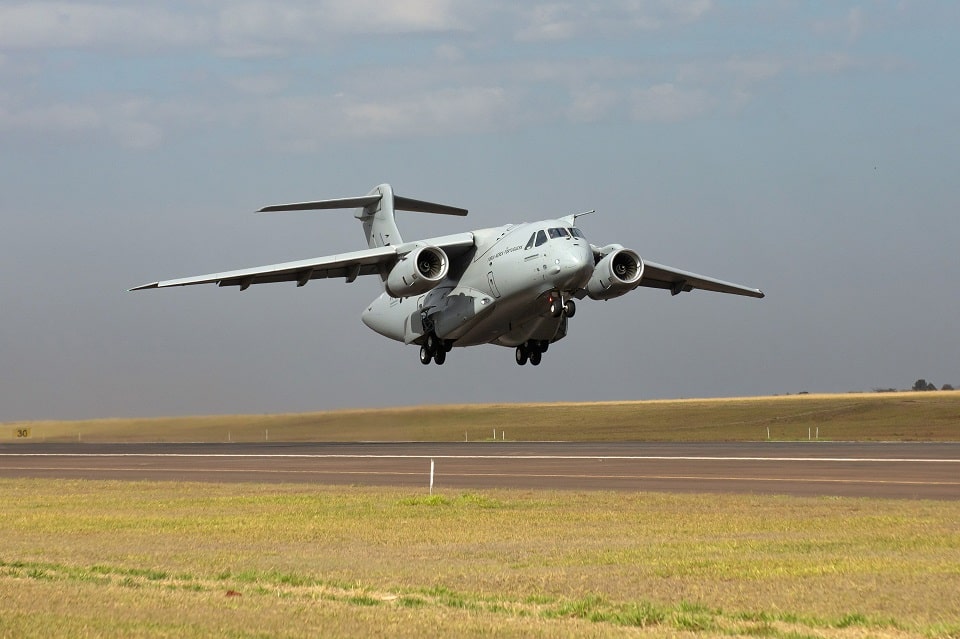Aerospace
First KC-390 Millennium in NATO configuration. What is NATO’s configuration for military aircraft?

The first KC-390 Millennium of the Portuguese Air Force (FAP) made its official debut as it entered into service at the Beja Air Base. This significant milestone marked the culmination of a meticulous process to ensure that the aircraft adhered to the stringent requirements stipulated by the National Aeronautical Authority (AAN) of Portugal.
This remarkable aircraft was equipped with standard NATO (North Atlantic Treaty Organization) equipment, seamlessly integrated into its design. The successful integration of this equipment was the result of an extensive flight test campaign conducted right here in Portugal, showcasing a collaborative effort between Embraer, OGMA, and the Portuguese Air Force (FAP).
NATO, or the North Atlantic Treaty Organization, has established a robust framework for configuring military aircraft to foster interoperability and cohesion among its member nations. This configuration entails a comprehensive set of standards and guidelines, spanning various crucial elements within the realm of aviation technology and military readiness. The primary aim is to facilitate the seamless collaboration of military aircraft from NATO countries during joint operations and exercises, bolstering the effectiveness of the alliance.
The key components of NATO configuration for aircraft encompass the following:
- Communication Systems: NATO mandates standardized radio frequencies, encryption methods, and communication protocols. This standardization ensures that aircraft from diverse nations can communicate effortlessly during missions, promoting real-time coordination and information exchange.
- Avionics: The establishment of common avionics interfaces and systems streamlines the integration of diverse sensors and mission-specific equipment. This interoperability enables aircraft from different nations to operate collectively with optimized efficiency.
- Armament: A critical aspect of NATO configuration involves harmonizing weapon systems. This may include adhering to NATO-standard munitions and compatible weapons racks. The aim is to ensure that aircraft can share and utilize armaments seamlessly, regardless of their country of origin.
- Logistics: To facilitate the exchange of spare parts and the maintenance and support of aircraft during deployments, NATO enforces standardized logistics procedures. This helps member nations maintain their fleets and sustain operational readiness.
- Training: NATO configuration standards encompass common training and procedures to equip aircrews from various member nations with the skills and knowledge required to collaborate effectively. This mutual training ensures that personnel can operate jointly and efficiently.
- Safety Standards: Safety is paramount in military operations. NATO has implemented shared safety standards and procedures to enhance the safety of all personnel involved in NATO operations. These standards are continuously updated to align with technological advancements and changing operational requirements.
In summary, the NATO configuration for aircraft serves as a foundational framework that allows military aircraft from member countries to operate in concert seamlessly. This harmonization enhances the collective capabilities of the alliance and ensures that NATO forces can respond effectively to a wide range of security challenges.

Aerospace
Boeing Transfers Rocket Stage to NASA, Paving Way for Human Moon Mission

Boeing has achieved a significant milestone by providing NASA with the second core stage of the Space Launch System (SLS) rocket.
This crucial component, crafted at NASA’s Michoud Assembly Facility (MAF), is set to propel the Artemis II crew into lunar orbit, marking humanity’s return to deep space after a 50-year hiatus.
The monumental Boeing-built rocket stage, the largest element of the Artemis II mission, will embark on a journey aboard the Pegasus barge, traveling 900 miles to NASA’s Kennedy Space Center.
Comparison of two legendary aircraft B777x vs B747 aircraft:Click here
Upon arrival, it will be meticulously integrated with other essential Artemis II components, including the upper stage, solid rocket boosters, and NASA’s Orion spacecraft within the iconic Vehicle Assembly Building. This intricate integration process is a vital step toward the eagerly anticipated Artemis II launch, slated for 2025.
“Boeing-built products helped land humankind on the moon in 1969, and we’re proud to continue that legacy through the Artemis generation,” remarked Dave Dutcher, vice president and program manager for Boeing’s SLS program. “Together, with NASA and our industry partners and suppliers, we are building the world’s most capable rocket and paving the way to deep space through America’s rocket factory in New Orleans.”
NASA, Lockheed Martin Reveal X-59 Quiet Supersonic Aircraft:Click here
The delivery of Core Stage 2 marks a significant achievement in the evolution of the SLS rocket. Towering over 200 feet and powered by four RS-25 engines, this core stage, coupled with two solid-fueled booster rockets, will generate a staggering 8.8 million pounds of thrust. This immense power is crucial to launching Artemis II and future missions into the vast expanse of space.
The SLS rocket stands unparalleled in its capability to transport both crew and substantial cargo to the moon and beyond in a single launch. Its extraordinary capacity will facilitate the delivery of human-rated spacecraft, habitats, and scientific missions to destinations including the moon and Mars, ushering in a new era of space exploration.
-

 Travel1 week ago
Travel1 week agoAir India to Expand US Operations with Three New Routes After a Decade
-

 Travel2 weeks ago
Travel2 weeks agoWhy We Should Avoid These Stamps in a Passport
-

 Airlines1 month ago
Airlines1 month agoInvestigations Reveal Fake Chinese Titanium in Boeing and Airbus Jets
-

 Tech4 weeks ago
Tech4 weeks agoChina’s CATL Plans 1,800-Mile Electric Plane Launch by 2027
-

 Airport3 days ago
Airport3 days agoTop 10 Largest Airports in the World by Size
-

 Aerospace4 weeks ago
Aerospace4 weeks agoChina’s Fighter Jets Turn Wings into Autonomous Drones
-

 Airlines4 days ago
Airlines4 days agoAir India Rolls Out A350s for Delhi-New York JFK and Newark Routes
-

 Defence3 weeks ago
Defence3 weeks agoBoeing Enhances Chinook with New Engines and Block II Upgrades at $96 Million







